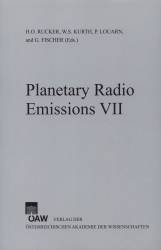
Planetary Radio Emissions VII, pp. 187-188, 2011/12/28
Proceedings of the 7th International Workshop on Planetary, Solar and Heliospheric Radio Emissions held at Graz, Austria, September 15–17, 2010

We compare a large database of Jovian DAM ‘great arcs” events with the most recent compilation of Io footprint (IFP) properties obtained from HST images of Jupiter UV auroras. The radio data was built from the last 16 years of Jupiter radio monitoring by the Wind/WAVES space experiment and by the Decameter array in Nan¸cay, and contents more than 3500 individual events. The analysis of this huge statistics lead to the following conclusions: ”Great arcs” can be found on spectrograms of both Io and non-Io controlled emissions (in nearly equal proportion), showing that the arc phenomenon is not specific to the particular Io-Jupiter interaction scenario. In the case of Io-controlled events, the observed arc curvatures and senses of circular polarisation, show that most of the observed events originate from one or several of the four possible high latitude limbs (corresponding to the well known A,B,C and D ‘regions” in CML-Io phase diagram). In each region, a close relationship exists, at a given frequency, between observer’s direction and Io’s orbital position at the time of the event; already reported as “DE effect”, it means a surprisingly tight beaming constraint. By using reference IFP ovals (Bonfond et al., JGR 114, 2009) and magnetic field model (VIP4), the emission angle can be estimated for each individual events. When counting from magnetic field direction at the source location, the distribution of emission angles is broadly centred on ~ 70?, as previously determined by many authors. The distribution gets narrowed when the magnetic field gradient is rather used, suggesting that the observed emission angle depends primarily on propagation conditions near the source. Because of the limited accuracy of available magnetic field models, it is unclear whether our estimate of a ~ 10? “lead angle” between the active radio field line footprint and the auroral IFP, can be considered as statistically significant or not.